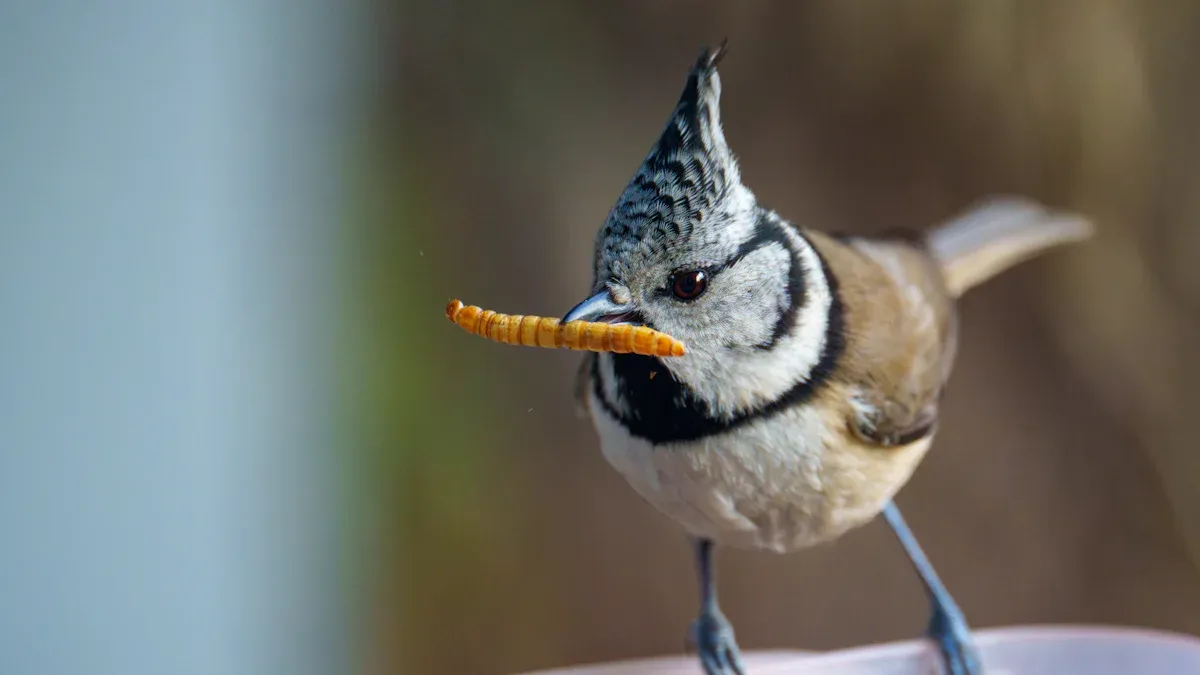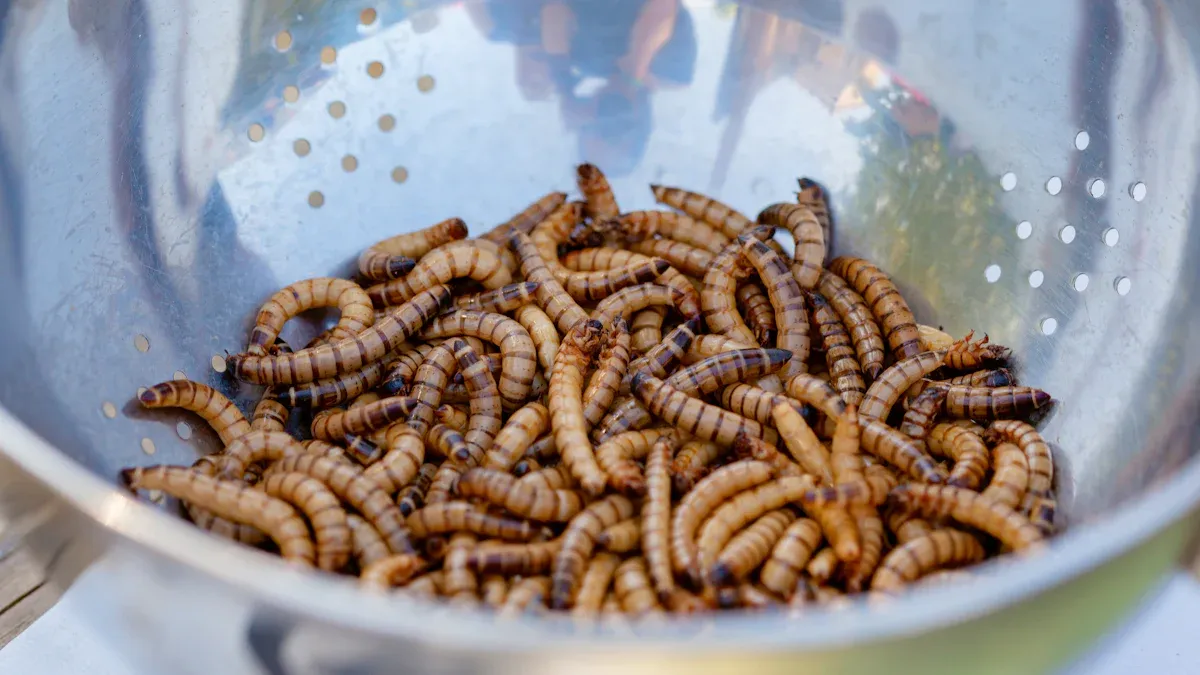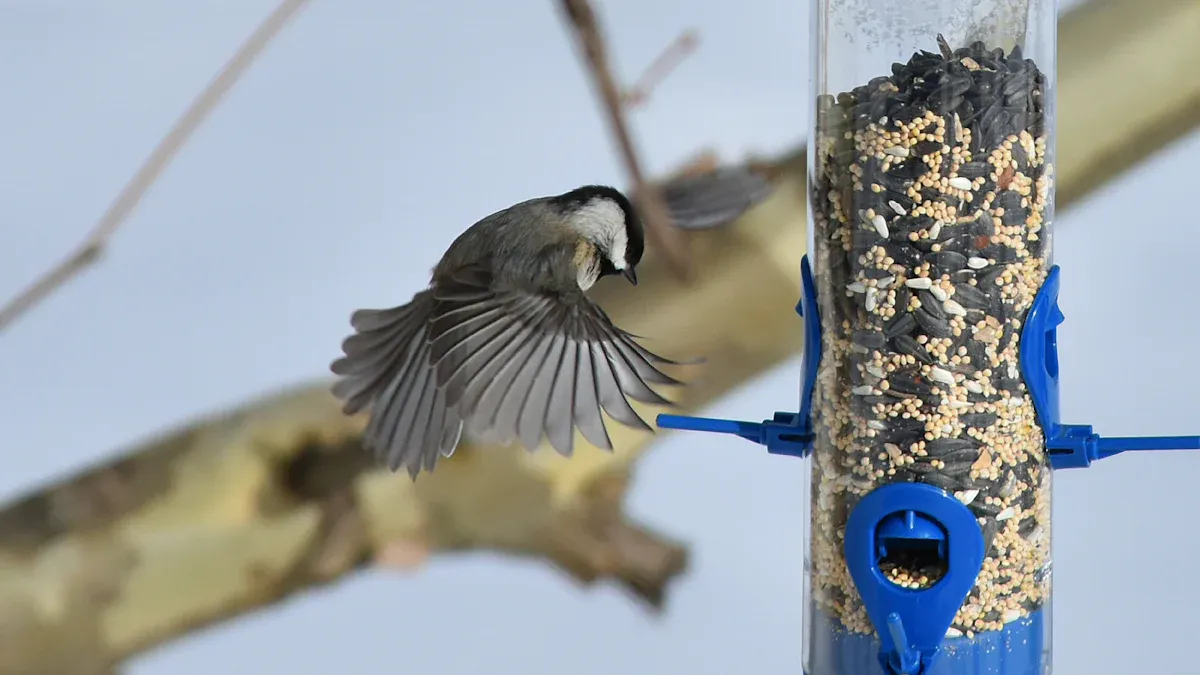
Dried mealworms pack a punch when it comes to nutrition for wildlife. They’re loaded with about 50% protein by weight, which helps birds and other animals build strong muscles and grow healthy feathers. Their fat content, around 25%, provides much-needed energy, especially during colder months or breeding seasons. Plus, they’re rich in essential nutrients like Vitamin B12, Calcium, and Iron, which support immune health and overall well-being. Research even shows that the amino acid profile of mealworms protein per 100g aligns perfectly with the dietary needs of many bird species, making them a top choice for wildlife enthusiasts.
🐦 Fun Fact: Eastern Bluebirds fed dried mealworms have been found to raise healthier chicks with higher fledging rates!
Key Takeaways
- Dried mealworms are very nutritious. They have 50% protein and 25% fat. This makes them great for helping wildlife stay healthy and energetic.
- These mealworms are simple to store and last a long time. This means you can keep them without worrying they will go bad.
- 먹이는 말린 Mealworms can bring many types of animals to your yard. This helps increase different species and makes your yard more lively.
Nutritional Composition of Dried Mealworms

Mealworms Protein per 100g: A High-Protein Powerhouse
Protein is essential for wildlife, and dried mealworms deliver it in abundance. With approximately 50% protein by weight, they surpass many traditional wildlife food sources. This makes them a standout choice for animals needing a protein boost. Birds, for instance, rely on protein to grow strong feathers and maintain muscle health. Reptiles and amphibians also benefit from this nutrient-rich snack.
🐾 Did you know? Compared to seeds or fruits, dried mealworms provide significantly higher protein levels, making them a superior option for wildlife nutrition.
The amino acids in mealworms protein per 100g align closely with the dietary needs of many species. This ensures that animals not only get enough protein but also the right kind for their bodies. Whether it’s a bird preparing for migration or a squirrel recovering from winter, mealworms offer the perfect protein-packed solution.
Healthy Fats and Energy for Wildlife
Dried mealworms are more than just protein. They also contain about 25% fat, which serves as a vital energy source. Wildlife often faces energy challenges, especially during colder months or migration periods. The healthy fats in mealworms help animals maintain their energy levels and stay active.
These fats include essential fatty acids, which play a key role in growth and overall health. Birds, for example, use this energy to fuel long flights or care for their young. By offering dried mealworms, you’re providing wildlife with the energy they need to thrive.
Essential Vitamins and Minerals for Optimal Health
Dried mealworms are packed with essential vitamins and minerals that support wildlife health. They contain Vitamin B12, which aids in red blood cell formation and brain function. Calcium strengthens bones and teeth, while Iron helps transport oxygen in the blood.
Here’s a quick look at some of the nutrients found in mealworms:
- Vitamin E: Protects cells from damage.
- Zinc: Boosts immune function and aids wound healing.
- 마그네슘: Supports various bodily functions.
These nutrients make dried mealworms a well-rounded food source. They don’t just fill bellies—they enhance health and vitality.
Practical Benefits of Using Dried Mealworms
Long Shelf Life and Easy Storage
Dried mealworms are a dream for wildlife enthusiasts who value convenience. Unlike live mealworms, they don’t require special care or humidity levels. Their long shelf life means you can stock up without worrying about spoilage. Many come in resealable bags, keeping them fresh and safe from pests.
🛠️ Tip: Store dried mealworms in a cool, dry place to maintain their quality for months.
Handling dried mealworms is also less messy compared to live ones. They’re easy to store in bulk, reducing waste and ensuring you always have a reliable food source on hand. This makes them perfect for bird feeders who may not have time to manage live food.
Versatile Feeding Methods for Different Wildlife
Dried mealworms cater to a wide range of wildlife species. Birds like blue jays, robins, and wrens love them, especially during winter when natural food is scarce. They also attract less common visitors, such as woodpeckers and migratory birds.
For reptiles, dried mealworms can be offered whole or crushed, depending on the species. Turtles, lizards, and even snakes benefit from the essential nutrients they provide. This versatility makes them a go-to option for wildlife enthusiasts looking to support diverse species.
🐦 Fun Fact: Adding dried mealworms to your bird feeder can encourage natural foraging behaviors in your backyard visitors!
Cost-Effective and Convenient Food Source
Dried mealworms are not only nutritious but also cost-effective. Compared to traditional livestock, they require fewer resources to produce, making them an environmentally friendly choice. Their long shelf life further enhances their value, as you can buy in bulk without worrying about waste.
Mealworms also have a lower environmental footprint. Producing protein from mealworms uses significantly less feed than cattle farming. Plus, they can be grown using organic waste, promoting sustainability. This makes them a smart choice for eco-conscious wildlife enthusiasts.
Ecological and Behavioral Impacts of Dried Mealworms

Attracting Diverse Wildlife Species
Dried mealworms are a magnet for a wide variety of wildlife. Birds, in particular, find them irresistible due to their high nutritional value. Species like American Robins and Black-capped Chickadees flock to feeders offering mealworms, especially during seasons when natural food sources are scarce. Woodpeckers and White-breasted Nuthatches also enjoy this protein-packed treat, making them frequent visitors to mealworm feeders.
Here’s a quick look at some bird species commonly attracted to dried mealworms:
| Bird Species | Attraction Details |
|---|---|
| American Robins | Prefer dried mealworms, especially during spring and summer for feeding young. |
| Woodpeckers | Frequent visitors to mealworm feeders, supplementing their diet with dried mealworms. |
| Black-capped Chickadees | Visit feeders more in winter for high-fat content of mealworms. |
| White-breasted Nuthatches | Increased visits to feeders with mealworms, particularly in early spring. |
| European Starlings | Attracted to mealworms, often dominating feeding stations due to their opportunistic feeding behavior. |
By offering dried mealworms, wildlife enthusiasts can attract a diverse array of species to their backyards, creating a lively and vibrant environment.
Supporting Breeding and Nesting Success
Dried mealworms play a crucial role in supporting the breeding and nesting success of birds. Their high protein content, around 50% by weight, provides the essential nutrients needed for chick growth and survival. A study by the North American Bluebird Society revealed that Eastern Bluebirds fed with mealworms during the breeding season raised healthier chicks with higher survival rates.
Similarly, research by the Royal Society for the Protection of Birds (RSPB) found that nestlings receiving mealworm supplements grew faster and had better survival chances. This highlights how mealworms protein per 100g meets the dietary needs of both parent birds and their young, ensuring a thriving population. Offering dried mealworms during the breeding season can make a significant difference in the health and success of local wildlife.
Encouraging Natural Foraging Behaviors
Feeding dried mealworms can influence the natural foraging behaviors of wildlife. While they provide a reliable food source, it’s important to consider how they might impact animals’ instincts.
Feeding dried mealworms can alter the natural foraging behavior of birds. Birds that have regular access to mealworms at feeders may become less inclined to forage for a diverse range of natural foods. This can lead to a reduction in foraging skills and efficiency.
Wildlife enthusiasts should aim to strike a balance. Here are a few considerations:
- The artificial abundance of food can alter natural foraging behaviors.
- Birds relying heavily on feeders may reduce their natural foraging activities, potentially affecting the balance of local insect populations.
By offering mealworms in moderation, you can encourage wildlife to maintain their natural foraging habits while still benefiting from this nutritious food source.
Tips for Safe Storage and Feeding
Proper Storage to Maintain Freshness
Storing dried mealworms correctly ensures they stay fresh and nutritious for months. Improper storage can lead to spoilage, which makes them unsafe for wildlife. Follow these tips to keep your mealworms in top condition:
- Store them in a cool, dry place, away from direct sunlight and moisture.
- Use an airtight container to prevent exposure to air, which can degrade nutrients.
- Check for signs of moisture, mold, or unusual odors before feeding.
When stored properly, dried mealworms can last six months to a year. Keeping them fresh not only benefits wildlife but also saves you money by reducing waste.
🛠️ Tip: Label your container with the purchase date to track freshness easily.
Rehydrating Mealworms for Certain Species
Some wildlife species, like nestlings or reptiles, may find dried mealworms too hard to eat. Rehydrating them makes them softer and easier to consume. This practice is especially helpful during hot weather when hydration is crucial.
To rehydrate mealworms:
- Place the desired amount in a bowl.
- Cover them with warm water and let them soak for 20-30 minutes.
- Drain the water and serve immediately.
Birds, in particular, benefit from rehydrated mealworms. A study by the Cornell Lab of Ornithology found that soaking mealworms increased their acceptance by birds. This simple step can make a big difference for your feathered visitors.
Avoiding Overfeeding and Ensuring a Balanced Diet
While dried mealworms are nutritious, overfeeding can cause problems. Wildlife that relies too much on mealworms may develop nutritional imbalances or lose their natural foraging instincts. To avoid these issues:
- Offer mealworms as a supplement, not the main diet.
- Rotate with other food sources like seeds, fruits, or suet.
- Limit the amount you provide daily to prevent dependency.
Overfeeding can also attract predators or increase the risk of disease transmission among birds. By feeding in moderation, you can support wildlife health while maintaining a balanced ecosystem.
🐦 Note: A little goes a long way. Use mealworms to complement, not replace, natural food sources.
Dried mealworms offer a nutritious and practical way to support wildlife. Their high protein and fat content make them ideal for birds and other animals. To maximize their benefits:
- Store them in a cool, dry place to prevent spoilage.
- Use airtight containers to maintain freshness.
- Soak them before feeding to help nestlings.
By following these tips, wildlife enthusiasts can enjoy the rewards of attracting vibrant species to their yards.
제품 정보
What types of wildlife benefit the most from dried mealworms?
Birds, reptiles, amphibians, and small mammals benefit greatly. Species like bluebirds, robins, and turtles thrive on their high protein and fat content.
Can dried mealworms replace natural food sources for wildlife?
No, they should only supplement natural diets. Over-reliance can disrupt foraging behaviors and lead to nutritional imbalances. Moderation is key for maintaining a balanced ecosystem.
Are dried mealworms safe for all wildlife species?
Yes, they’re generally safe. However, rehydrating them is recommended for nestlings or species with difficulty consuming hard foods. Always monitor feeding to avoid overfeeding.
🐦 Tip: Offer mealworms in moderation alongside seeds or fruits to ensure a varied diet for wildlife visitors.


